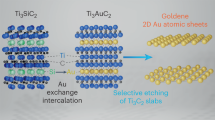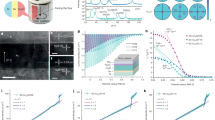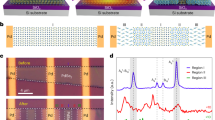Abstract
Solution-processed electronic1 and optoelectronic2,3,4,5 devices offer low cost, large device area, physical flexibility and convenient materials integration compared to conventional epitaxially grown, lattice-matched, crystalline semiconductor devices. Although the electronic or optoelectronic performance of these solution-processed devices is typically inferior to that of those fabricated by conventional routes, this can be tolerated for some applications in view of the other benefits. Here we report the fabrication of solution-processed infrared photodetectors that are superior in their normalized detectivity (D*, the figure of merit for detector sensitivity) to the best epitaxially grown devices operating at room temperature. We produced the devices in a single solution-processing step, overcoating a prefabricated planar electrode array with an unpatterned layer of PbS colloidal quantum dot nanocrystals. The devices showed large photoconductive gains with responsivities greater than 103 A W-1. The best devices exhibited a normalized detectivity D* of 1.8 × 1013 jones (1 jones = 1 cm Hz1/2 W-1) at 1.3 µm at room temperature: today's highest performance infrared photodetectors are photovoltaic devices made from epitaxially grown InGaAs that exhibit peak D* in the 1012 jones range at room temperature, whereas the previous record for D* from a photoconductive detector lies at 1011 jones. The tailored selection of absorption onset energy through the quantum size effect, combined with deliberate engineering of the sequence of nanoparticle fusing and surface trap functionalization, underlie the superior performance achieved in this readily fabricated family of devices.
This is a preview of subscription content, access via your institution
Access options
Subscribe to this journal
Receive 51 print issues and online access
$199.00 per year
only $3.90 per issue
Buy this article
- Purchase on Springer Link
- Instant access to full article PDF
Prices may be subject to local taxes which are calculated during checkout



Similar content being viewed by others
References
Talapin, D. & Murray, C. B. PbSe nanocrystal solids for n- and p-channel thin film field-effect transistors. Science 310, 86–89 (2005)
Tessler, N., Medvedev, V., Kazes, M., Kan, S. & Banin, U. Efficient near-infrared polymer nanocrystal light-emitting diodes. Science 295, 1506–1508 (2002)
Konstantatos, G., Huang, C., Levina, L., Lu, Z. & Sargent, E. H. Efficient infrared electroluminescent devices using solution-processed colloidal quantum dots. Adv. Funct. Mater. 15, 1865–1869 (2005)
Hoogland, S. et al. A solution-processed 1.53 µm quantum dot laser with temperature-invariant emission wavelength. Opt. Express 14, 3273–3281 (2006)
McDonald, S. A. et al. Solution-processed PbS quantum dot infrared photodetectors and photovoltaics. Nature Mater. 4, 138–142 (2005)
Schödel, R. et al. A star in a 15.2-year orbit around the supermassive black hole at the centre of the Milky Way. Nature 419, 694–696 (2002)
Rawlings, S. et al. A radio galaxy at redshift 4.41. Nature 383, 502–505 (1996)
Ettl, R., Chao, I., Diederich, F. & Whetten, R. L. Isolation of C76, a chiral (D2) allotrope of carbon. Nature 353, 149–153 (1991)
Walker, J. Tunable alkali halide lasers. Nature 256, 695 (1975)
Ettenberg, M. A little night vision. Adv. Imaging 20, 29–32 (2005)
Sargent, E. H. Infrared quantum dots. Adv. Mater. 17, 515–522 (2005)
Lim1, Y. T. et al. Selection of quantum dot wavelengths for biomedical assays and imaging. Mol. Imaging 2, 50–64 (2003)
Kim, S. et al. Near-infrared fluorescent type II quantum dots for sentinel lymph node mapping. Nature Biotechnol. 22, 93–97 (2004)
Petritz, R. L. Theory of photoconductivity in semiconductor films. Phys. Rev. B 104, 1508–1516 (1956)
Carbone, A. & Mazzetti, P. Grain-boundary effects on photocurrent fluctuations in polycrystalline photoconductors. Phys. Rev. B 57, 2454–2460 (1998)
Murray, C. B., Norris, D. J. & Bawendi, M. G. Synthesis and characterization of nearly monodisperse CdE (E = sulfur, selenium, tellurium) semiconductor nanocrystallites. J. Am. Chem. Soc. 115, 8706–8715 (1993)
Yu, D., Wang, C. & Guyot-Sionnest, P. n-Type conducting CdSe nanocrystal solids. Science 300, 1277–1280 (2003)
Wessels, J. M. et al. Optical and electrical properties of three-dimensional interlinked gold nanoparticle assemblies. J. Am. Chem. Soc. 126, 3349–3356 (2004)
Leatherdale, C. A. et al. Photoconductivity in CdSe quantum dot solids. Phys. Rev. B 62, 2669–2680 (2000)
Jarosz, M. V., Porter, V. J., Fisher, B. R., Kastner, M. A. & Bawendi, M. G. Photoconductivity of treated CdSe quantum dot films exhibiting increased exciton ionization efficiency. Phys. Rev. B 70, 195327 (2004)
Oertel, D. C., Bawendi, M. G., Arango, A. C. & Bulovic, V. Photodetectors based on treated CdSe quantum-dot films. Appl. Phys. Lett. 87, 213505 (2005)
Hines, M. A. & Scholes, G. D. Colloidal PbS nanocrystals with size-tunable near-infrared emission: observation of post-synthesis self-narrowing of the particle size distribution. Adv. Mater. 15, 1844–1849 (2003)
Yu, D., Wang, C., Wehrenberg, B. L. & Guyot-Sionnest, P. Variable range hopping mechanism in semiconductor nanocrystal solids. Phys. Rev. Lett. 92, 216802 (2004)
Rahada, R. H. & Minden, H. T. Photosensitization of PbS films. Phys. Rev. 102, 1258–1262 (1956)
Scher, H. Anomalous transit-time dispersion in amorphous solids. Phys. Rev. B 12, 2455–2477 (1975)
Acknowledgements
We thank D. Grozea and Z. H. Lu for XPS, E. Istrate for discussions, and V. Sukhovatkin for assistance in optical measurements. This research was supported by the Natural Sciences and Engineering Research Council (NSERC) of Canada, the Canada Foundation for Innovation, the Province of Ontario, and the Canada Research Chairs programme.
Author information
Authors and Affiliations
Corresponding author
Ethics declarations
Competing interests
Reprints and permissions information is available at npg.nature.com/reprintsandpermissions. The authors declare no competing financial interests.
Supplementary information
Supplementary Notes
This file contains Supplementary Notes 1–7. (DOC 915 kb)
Rights and permissions
About this article
Cite this article
Konstantatos, G., Howard, I., Fischer, A. et al. Ultrasensitive solution-cast quantum dot photodetectors. Nature 442, 180–183 (2006). https://doi.org/10.1038/nature04855
Received:
Accepted:
Issue Date:
DOI: https://doi.org/10.1038/nature04855
This article is cited by
-
Silver telluride colloidal quantum dot infrared photodetectors and image sensors
Nature Photonics (2024)
-
Bright and stable near-infrared lead-free perovskite light-emitting diodes
Nature Photonics (2024)
-
Metal Halide Perovskite for next-generation optoelectronics: progresses and prospects
eLight (2023)
-
Room-temperature high-speed electrical modulation of excitonic distribution in a monolayer semiconductor
Nature Communications (2023)
-
Phase-controlled van der Waals growth of wafer-scale 2D MoTe2 layers for integrated high-sensitivity broadband infrared photodetection
Light: Science & Applications (2023)
Comments
By submitting a comment you agree to abide by our Terms and Community Guidelines. If you find something abusive or that does not comply with our terms or guidelines please flag it as inappropriate.



